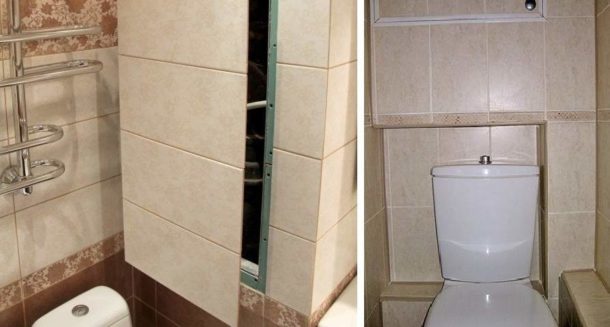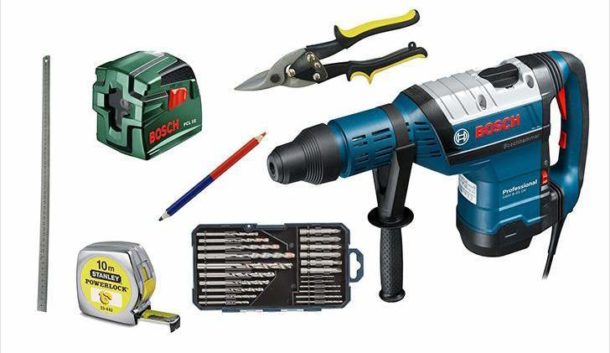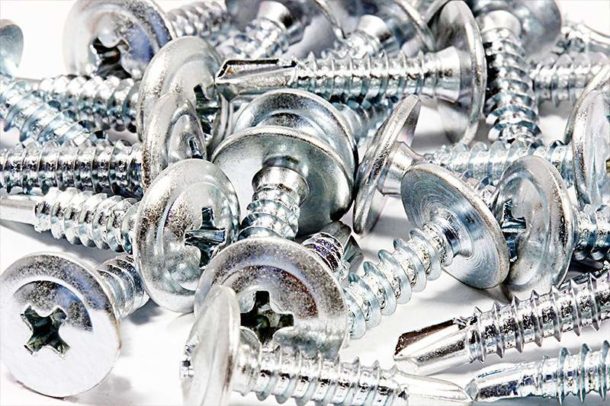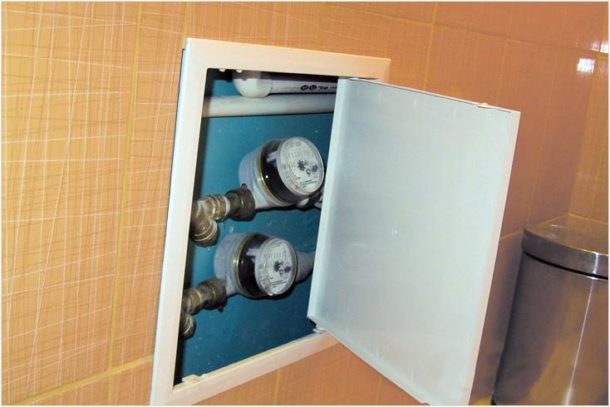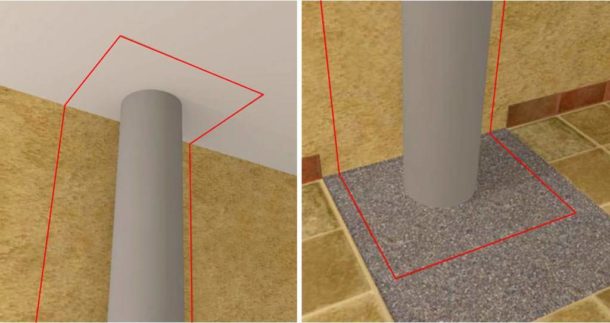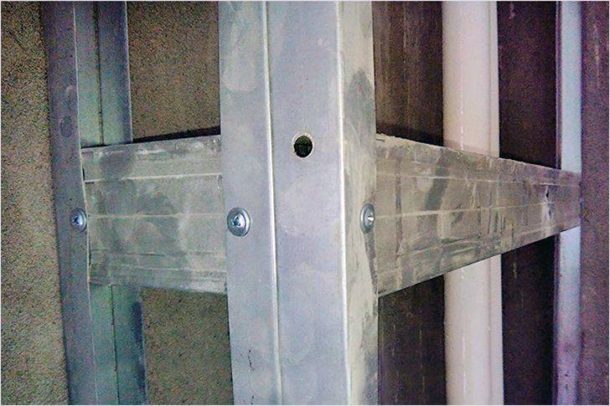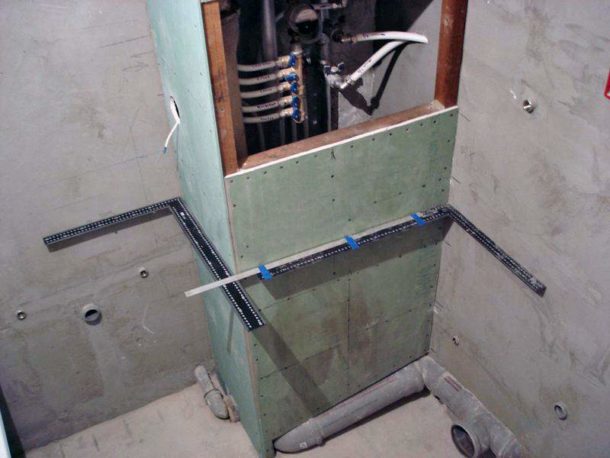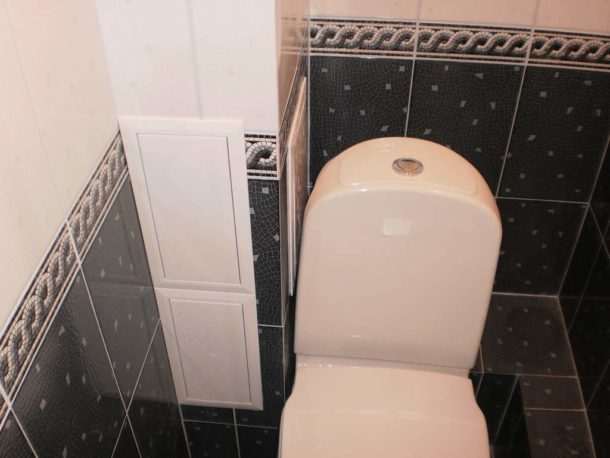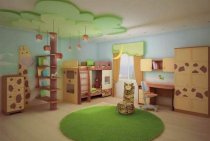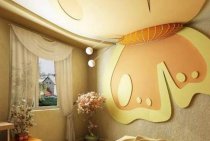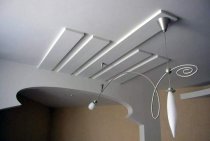Repair in the apartment concerns every room, the bathroom in this case is no exception. Modern plumbing equipment is compact and aesthetically pleasing. However, in Soviet-era apartments, there are old bulky pipes and risers that cannot be moved to another place or removed altogether. In this situation, a drywall box in the toilet comes to the rescue. This design looks neat and fits perfectly into any chosen style of the room.
Work materials
For the manufacture of the box, you can use any sheet material, as well as lining and PVC panels, but drywall is especially popular. It is easy to use and does not limit the choice of finishing materials.
For work, moisture-resistant drywall should be used to avoid damage to the material from exposure to high humidity in the toilet and from condensation that forms on the pipes.
For fixing drywall, it is necessary to prepare wooden bars or metallic profile two types: guide (UD) and bearing (CD). When making a frame from bars, each element must be treated with moisture-resistant and antiseptic agents. The galvanized profile does not need additional processing.
In addition to the main building material, you will need the following set of tools:
- Pencil or marker for drawing the outline.
- Roulette and building level, plumb.
- Sharp construction knife for cutting drywall.
- Metal shears for profile cutting.
- To fasten the structural elements, you will need a puncher, a hammer and a screwdriver.
Don't forget about fasteners:
- dowel-nails for fastening structural elements to the wall, floor and ceiling;
- self-tapping screws "bugs" for connecting metal profiles (they will not be needed if you have cutter);
- self-tapping screws for metal or wood for mounting the plasterboard on the frame (depending on the material chosen).
Pipe preparation, planning and marking
To answer the question of how to make a drywall box for pipes in the toilet with your own hands, it is advisable to study the drawings and diagrams of such structures in order to better imagine what you should be able to do and follow the recommendations of experts.
Attention! Before starting work, you need to inspect the pipes. Existing defects and breakdowns must be eliminated without fail.
If the pipes are connected by welding, then the box can be solid. Threaded pipe connections need regular inspection, in which case the pipes must be freely accessible.
Important! Valves, meters and filters must not be tightly closed.
The quality of work largely depends on proper planning:
- Before proceeding with the installation of the pipe box, you need to measure the walls and openings and draw a drawing on paper.
- The dimensions of the box should be minimal so as not to take up a lot of space in the toilet. At the same time, a distance of about 10 cm must be maintained from the pipes to the walls of the box.
If condensation forms on the cold water pipes, you need to put on them cases made of foamed polyethylene or paint them with a special heat-insulating paint. If this is not done, even moisture-resistant drywall may suffer over time.
- The contour of the future structure is marked on the floor, then transferred to the ceiling. A plumb line will help facilitate this process.
Frame installation
The sequence of work will be as follows:
- Guide profiles are installed along the contour, which is marked on the ceiling and on the floor.
- Vertical posts are attached to the walls.
- At the junction of the elements on the ceiling and on the floor, a protruding edge of the box is installed.
- The rigidity of the frame is achieved by installing transverse profiles between the vertical elements. The distance between them should not exceed 30 cm. These crossbars will serve as a place for attaching drywall sheets.
- On the plane, which will be directed towards the entrance, a viewing window is mounted.
Plasterboard sheathing
After assembling the frame, proceed to its sheathing.
- Take measurements from each plane of the frame, transfer them to drywall and cut out strips. The edges of the cut strips must be cleaned with sandpaper or treated with a peeling planer.
- For fixing drywall sheets to the frame, self-tapping screws and a screwdriver are used. The distance between the fasteners is no more than 25 cm. The screws should be screwed in at a right angle.
- To inspect the pipes in the toilet, a door is equipped in the partition.
Box finishing
Puttying and finishing, which are carried out in a certain sequence, will help to give the pipe box in the toilet a finished look:
- The first step in the mounted structure is the processing of joints. To do this, they are first primed, and then sealed with a starting or special putty using a reinforcing tape - paper or sickle.
- After the joints have dried, a layer of primer is applied on the plane of the box.
- The edges of the box are made out with a plastic or metal corner, which is glued to a thin layer of putty, and then covered with a putty mixture. After drying, the corners are carefully polished.
- The entire surface of the structure is covered with putty in several layers, each time you need to wait for the material to dry completely.
- The dried surface is rubbed and polished.
Tiles, wallpaper, water-based paint can be used to finish the box. The main thing is that the style of finishing the box is in harmony with the rest of the repair in the toilet.
Important Points
Summing up, there are several important points that cannot be neglected when installing a pipe box in a toilet:
- In places that require periodic inspection, you need to cut a window. You can put a special door on hinged frogs on it.
- Doors are also required in areas where there is a meter or valve.
- Approach for periodic revision is best done on the front of the structure. A door for any equipment can be mounted on the side panel of the box.
- Pipe joints may need repair, so it is important to leave free passage to them.
- If the pipe bends are located beyond the edge of the box, then the hole for them is cut out a little more. In the future, the gap between the pipes and the box is filled with expanded polystyrene foam so that the vibration of the pipes is not transmitted to the box.
A do-it-yourself box in the toilet will not only hide unattractive pipes and risers, but also give the room a beautiful finished look.
